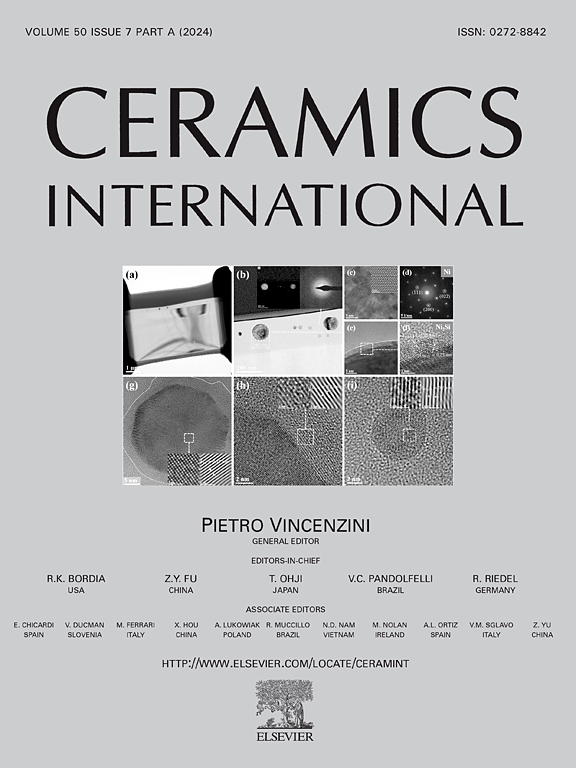低氮压下燃烧合成高烧结活性氮化硅粉体
IF 5.6
2区 材料科学
Q1 MATERIALS SCIENCE, CERAMICS
引用次数: 0
摘要
本研究以硅和氮化硅粉为反应物,镁粉为点火剂,在低压氮气气氛(0.2 MPa)下,采用自传播高温合成(SHS)法制备了具有高α相含量和棒状晶体形态的氮化硅粉。系统地研究了硅与氮化硅的不同配比对合成的氮化硅粉体的相组成、晶体形态和烧结活性的影响。结果表明,在低压条件下控制氮化硅硅比对α-相Si3N4的形成及粉末的微观组织有显著影响。在动力学和热力学分析的基础上,采用了低压氮气气氛,为SHS提供了可行的环境。值得注意的是,在反应过程中,原位形成的氮化镁(MgSiN2)不仅作为有效的助烧结剂,而且还提高了所得Si3N4陶瓷的导热性。使用65% Si的原料组成反应产生的粉末最大程度地减少了硅的渗透和熔化,因此,烧结的氮化硅陶瓷表现出最高的导热性。低压环境有效地减缓了反应速率和温度,促进了具有棒状形貌的α-相Si3N4晶粒的形成。这种创新的方法为生产具有高烧结活性的高质量氮化硅粉末提供了一种经济、环保的方法。本文章由计算机程序翻译,如有差异,请以英文原文为准。

Combustion synthesis of Si3N4 powders with high sintering activity under low nitrogen pressures
In this study, silicon nitride (Si3N4) powders with high α-phase content and rod-like crystal morphologies were synthesized via self-propagating high-temperature synthesis (SHS) in a low-pressure nitrogen atmosphere (0.2 MPa), using silicon and Si3N4 powders as reactants, with magnesium powder serving as an igniter. The influence of different ratios of silicon to silicon nitride on the phase composition, crystal morphology, and sintering activity of the synthesized Si3N4 powders was systematically investigated. The results demonstrated that controlling the silicon-to-silicon nitride ratio under low-pressure conditions significantly affects the formation of α-phase Si3N4 and the resulting microstructure of the powders. A low-pressure nitrogen atmosphere was adopted based on kinetic and thermodynamic analyses, providing a feasible environment for SHS. Notably, in situ formation of magnesium nitride (MgSiN2) during the reaction not only acted as an effective sintering aid but also improved the thermal conductivity of the resulting Si3N4 ceramic. The powder produced from a reaction using a raw material composition of 65 % Si minimizes both silicon infiltration and melting to the greatest extent, and consequently, the sintered silicon nitride ceramics exhibit the highest thermal conductivity. The low-pressure environment effectively moderated the reaction rate and temperature, promoting the formation of fine α-phase Si3N4 particles with rod-like morphologies. This innovative method offers a cost-effective and environmentally friendly approach for producing high-quality Si3N4 powders with high sintering activity.
求助全文
通过发布文献求助,成功后即可免费获取论文全文。
去求助
来源期刊

Ceramics International
工程技术-材料科学:硅酸盐
CiteScore
9.40
自引率
15.40%
发文量
4558
审稿时长
25 days
期刊介绍:
Ceramics International covers the science of advanced ceramic materials. The journal encourages contributions that demonstrate how an understanding of the basic chemical and physical phenomena may direct materials design and stimulate ideas for new or improved processing techniques, in order to obtain materials with desired structural features and properties.
Ceramics International covers oxide and non-oxide ceramics, functional glasses, glass ceramics, amorphous inorganic non-metallic materials (and their combinations with metal and organic materials), in the form of particulates, dense or porous bodies, thin/thick films and laminated, graded and composite structures. Process related topics such as ceramic-ceramic joints or joining ceramics with dissimilar materials, as well as surface finishing and conditioning are also covered. Besides traditional processing techniques, manufacturing routes of interest include innovative procedures benefiting from externally applied stresses, electromagnetic fields and energetic beams, as well as top-down and self-assembly nanotechnology approaches. In addition, the journal welcomes submissions on bio-inspired and bio-enabled materials designs, experimentally validated multi scale modelling and simulation for materials design, and the use of the most advanced chemical and physical characterization techniques of structure, properties and behaviour.
Technologically relevant low-dimensional systems are a particular focus of Ceramics International. These include 0, 1 and 2-D nanomaterials (also covering CNTs, graphene and related materials, and diamond-like carbons), their nanocomposites, as well as nano-hybrids and hierarchical multifunctional nanostructures that might integrate molecular, biological and electronic components.
 求助内容:
求助内容: 应助结果提醒方式:
应助结果提醒方式:


